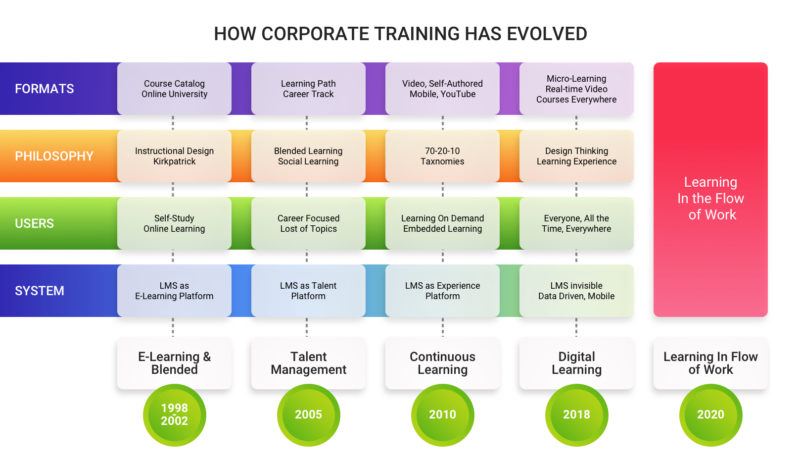The Top Corporate eLearning Trends Of 2020
When a company hires a new employee, it is important that the new member is introduced to the workflow almost immediately in order to maximize the team’s efficiency. However, this objective requires an organized onboarding process, where a new member goes through SMART training and is able to see clear progress. This can be achieved through eLearning—the practice of digital education. According to the Global Industry Analysis, the eLearning market will reach $325 billion by 2025. Using digital systems to organize learning practices makes educational investments more transparent, which is exactly what corporations are lacking in the onboarding process. Employee skill and productivity requirements are constantly changing, regardless of the industry. Technology-related changes introduce new trends to learning curves, and it’s immediately reflected in eLearning practices. Let’s take a look at the most noticeable corporate eLearning trends in 2020 and see how brands can adapt their workflow.
1. Learning Experience Platforms
Today, when you hear eLearning, it usually doesn’t only mean using digital sources to educate employees, but rather, working with personalized online education platforms. Now, employees don’t have to figure out a way to store digital materials and measure their workflow, they have dedicated tools that apply tangible metrics to their learning process. Corporate learning has been a profitable field in software development and human resources for quite a while. This trend remains for 2020 as well.

Features of corporate eLearning platforms:
- Peer-to-peer education
Team members can help each other, ask questions, and discuss learning subjects directly in the platform. - Learning as a part of the work process
Employees are getting paid for their learning hours. - Visualization
Learning software allows the creation of graphs, flowcharts, and diagrams for new content and displays the learning progress as visuals. - Mobile corporate learning
Many custom platforms support iOS and Android devices along with tablets and laptops.
Using dedicated platforms makes the learning process more transparent and easier to reward; managers and business owners can track their employees’ results and promptly update the requirements. To make the most out of eLearning, companies prefer to develop custom learning software rather than using ready-made solutions. Such an approach allows them to adapt to the company’s niche and needs as well as take employees’ opinions into account.
2. Learner Analysis And Reporting
In 2020, learner analytics are likely to develop at an incredible pace due to the progress of Big Data and AI technologies. Now, the platforms that have SMART data analytics and Machine Learning algorithms are equipped to analyze learners’ activities automatically and comply with reports on their efficiency. Basically, today analytics doesn’t require any human involvement, since data collection, analysis and monitoring can be performed entirely by the algorithms.
This smart analysis allows companies to get alerts whenever the employee doesn’t understand the topic or seems to have execution difficulties. Some employees are open to sharing their learning issues, and if not for analytics, these troubles could’ve been easily overlooked. With smart analytics, understanding an individual level of competence and skill will be much easier.
3. AI-Powered eLearning Solutions
eLearning requires constant data analysis—employees will make regular progress and transfer more data to the server. For humans, taking care of all that information and making an educated conclusion would be a time-consuming task. The feedback wouldn’t be timely, and experts would end up identifying the issue after it had already been resolved or forgotten about. AI processes this information automatically and draws conclusions in comprehensive reports, this considerably shortens the feedback loop between HR and the employee.
AI-based learning tools:
- Zoomi
An AI educational tool that creates learning schedules, determines results, and creates final reports based on regular assessments. - KEA
An AI software for corporate IT education that creates study plans, analyzes work quality, connects new developers to members, collects feedback, and provides reports. - Docebo
A smart learning platform where employees can upload courses for employees and get automated reports on their efficiency, see real-time leaderboards, and measure tangible scores.
Artificial Intelligence has the immense potential to revolutionize eLearning and minimize time expenses. Onboarding won’t be a burden on team members because the platform will provide all education-related information automatically—one glance would be enough to be updated.
4. Work-Life Coaching
According to LinkedIn Learning, companies should focus on skills that aren’t related to a particular industry but can improve all work-related aspects as well as improve employees' lives overall. These qualities include leadership, creativity, time-management, communication, and problem-solving. They are known as work-life skills and are important because they allow people to adapt to changes and face challenges better. What’s more, companies should invest in teaching employees to self-learn and self-manage.
5. Independent Learning
According to Towards Maturity’s report, 96% of L&D teams prefer to direct their own education process. While employees wouldn’t mind having guidance in place, they would rather adapt it to their needs and schedules. This means employees have to provide searchable data catalogs and personalized suggestions. AI can analyze an employee’s learning preferences and pick content that fits these interests the most, while still being relevant to the company’s interests.
Also, employees should be able to track the results of their work and change the process accordingly. As soon as there is a negative dynamic, the software should alert the user and offer suggestions on how to maximize efficiency. It’s important that a team member can make these changes on their own terms without having to contact the manager all the time.
Bottom Line
Efficient corporate learning is about introducing changes to employees’ mindsets. According to Deloitte’s report on unlocking human potential, the key goal is to make a difference in anchoring work-life balance. Work skills should correlate with employees’ everyday needs. If the team seizes an opportunity to apply the knowledge and skills gained from eLearning to better decision making or solving real-life problems, it will improve motivation and efficiency.









